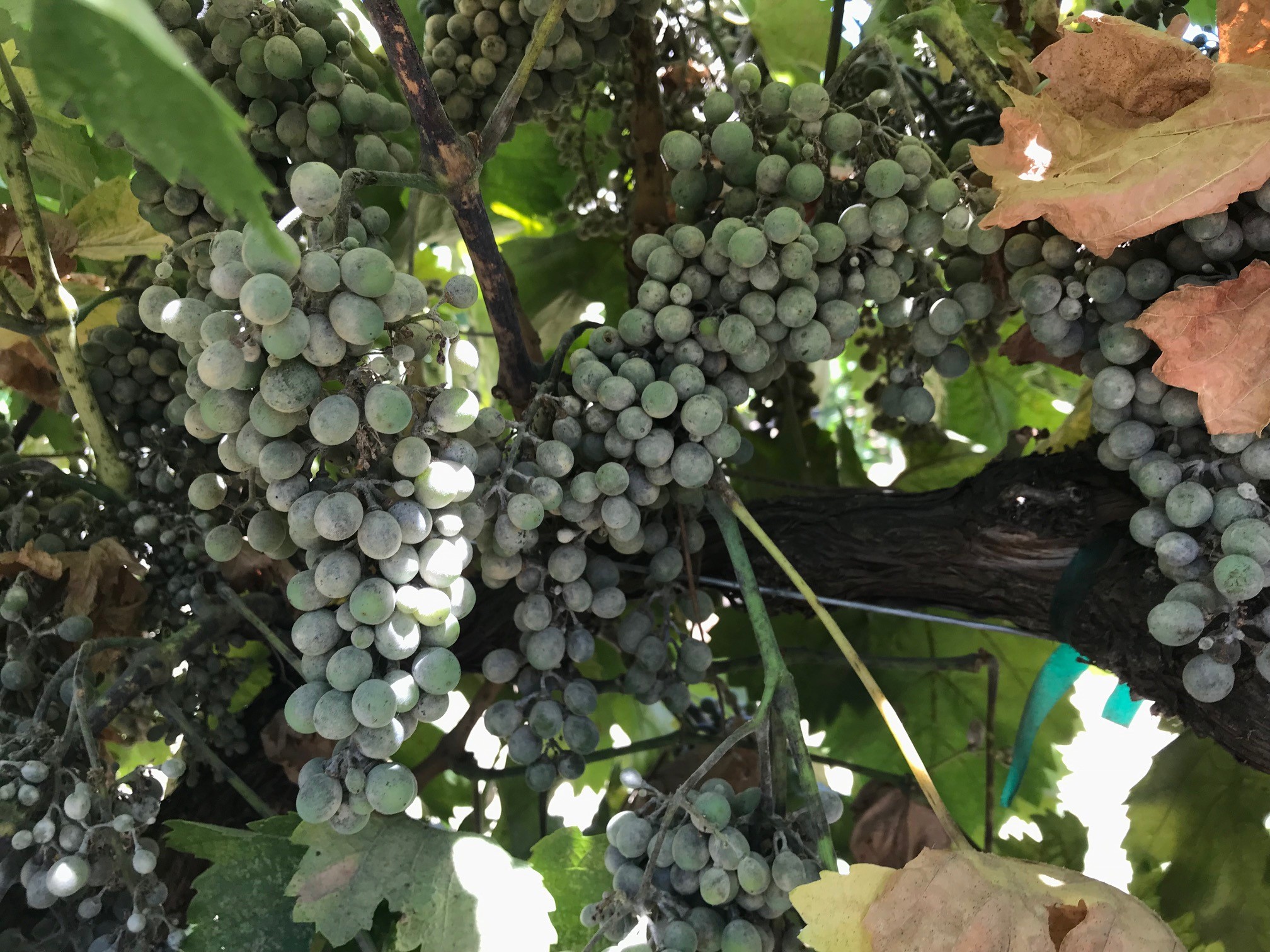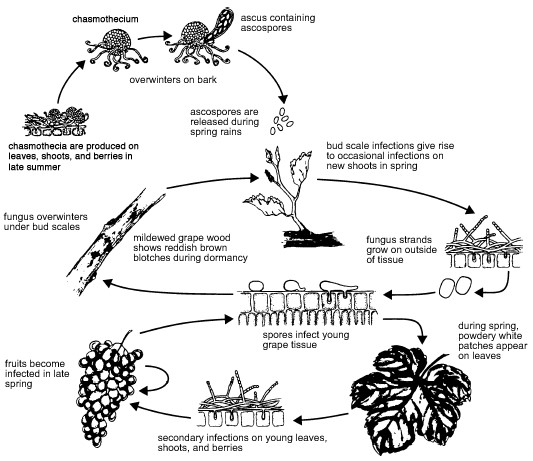Powdery Mildew Control in Grape Vineyards
December 13, 2021
Background
Powdery mildew of grape is caused by the fungus Erisyphe necator. The characteristic sign of this pathogen is the fuzzy white/gray patches of mycelium, found on any living green tissue of the plant including leaves, stems, and fruit. The general effect of powdery mildew on grapes is a reduction in photosynthesis, reduced shoot growth, and potential for reduced fruit set and quality. Powdery mildew tends to be more aggressive on Vitis vinifera varieties native to Europe and less aggressive on Vitis labrusca varieties native to North America. The most economically damaging effect of powdery mildew on grapes is infections of the fruit which weaken and crack berry skins and contribute to secondary fruit rot. In addition, infections of the grape bunches reduce marketability of table grape varieties and may impart negative flavors to the juice during the wine-making process.
Conditions Leading to Powdery Mildew
Powdery mildew infections initiate after budbreak if there is sufficient free moisture to hydrate overwintering clasmothecia, and temperatures are at least 50° F. After powdery mildew is established in the vineyard, new cycles of infection can occur through asexual conidiospores rapidly – a new generation every 5-7 days – if canopy temperature conditions are in the optimal range of 70°-85° F. Overly vigorous canopy growth increases susceptibility to powdery mildew infection. In season leaf removal and shoot thinning can improve light penetration and airflow which helps manage powdery mildew. Also, younger tissue is more susceptible to infection than older, hardened-off structures. Thus, it is especially important to keep mildew off the bunches from the period of rachis elongation to pea-sized berries.
Control of Powdery Mildew
In addition to implementing cultural practices, timely fungicide applications are essential to manage this disease. Powdery mildew sprays should typically start around 3-10 inch shoot growth, preferably before clusters become visible. Prior to rachis elongation, sulfur or horticultural oils generally work well to keep mildew levels low. TriTek is a mineral oil formulation that provides good control of powdery mildew. Where it comes into contact with the powdery mildew fungus, it smothers existing mycelia, conidiospores, and conidia bearing structures on the surface of the leaf, and leaves a protective layer on the plant surface that prevents spores from attaching. With its unique inverse emulsion, TriTek produces smaller oil droplets when diluted in the spray tank giving better coverage and reduced phytotoxicity versus conventional spray oil formulations.
Once rachis elongation begins, the grape bunch becomes increasingly susceptible to powdery mildew. During this time conventional growers should use synthetic fungicides from one or more of FRAC groups 3 (DMI fungicides), 7 (SDHI fungicides), 11 (QoI fungicides), 13 (aza-naphthalenes), and 19 (polyoxins). All of these products are primarily protectant fungicides. Tank mixing these materials with a potassium bicarbonate fungicide will add some curative activity to help clean up existing mycelia.
Potassium bicarbonate products work by: i) increasing pH of leaf surfaces which hinders spore germination, ii) increasing the osmotic potential around fungal spores drying them out, and iii) destabilizing cell membranes. Kaligreen is a potassium bicarbonate product with enhanced effectiveness because it has a proprietary surfactant system that forms contact liposomes. The contact liposomes have a great affinity for fungal cell walls, increasing contact between the potassium ion and the powdery mildew pathogen, which results in greater efficacy of the product. Kaligreen can be applied through the end of harvest to keep bunches clean and reduce overwintering inoculum going into next season.
Recommendations:
- TriTek
- Rate: 1-2% by volume
- Spray interval: 7-14 days depending on conditions and vine growth rate
- Avoid applications within 2 weeks of sulfur spray or during hot weather conditions
- Approved for organic use
- Kaligreen
- Rate: 2.5-5 lb per acre
- Spray interval: 7-10 days (potentially longer if tank mixed with a protectant fungicide)
- Avoid low pH tank mixes
- Approved for organic use

Severe powdery mildew symptoms on berries, stems, and rachis.

Source: ipm.ucanr.edu
